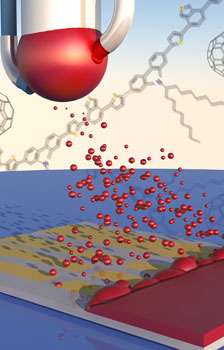Scientists develop pioneering new spray-on solar cells

(Phys.org) —A team of scientists at the University of Sheffield are the first to fabricate perovskite solar cells using a spray-painting process – a discovery that could help cut the cost of solar electricity.
Experts from the University's Department of Physics and Astronomy and Department of Chemical and Biological Engineering have previously used the spray-painting method to produce solar cells using organic semiconductors - but using perovskite is a major step forward.
Efficient organometal halide perovskite based photovoltaics were first demonstrated in 2012. They are now a very promising new material for solar cells as they combine high efficiency with low materials costs.
The spray-painting process wastes very little of the perovskite material and can be scaled to high volume manufacturing – similar to applying paint to cars and graphic printing.
Lead researcher Professor David Lidzey said: "There is a lot of excitement around perovskite based photovoltaics.
"Remarkably, this class of material offers the potential to combine the high performance of mature solar cell technologies with the low embedded energy costs of production of organic photovoltaics."
While most solar cells are manufactured using energy intensive materials like silicon, perovskites, by comparison, requires much less energy to make. By spray-painting the perovskite layer in air the team hope the overall energy used to make a solar cell can be reduced further.
Professor Lidzey said: "The best certified efficiencies from organic solar cells are around 10 per cent.
"Perovskite cells now have efficiencies of up to 19 per cent. This is not so far behind that of silicon at 25 per cent - the material that dominates the world-wide solar market."
He added: "The perovskite devices we have created still use similar structures to organic cells. What we have done is replace the key light absorbing layer - the organic layer - with a spray-painted perovskite.
"Using a perovskite absorber instead of an organic absorber gives a significant boost in terms of efficiency."
The Sheffield team found that by spray-painting the perovskite they could make prototype solar cells with efficiency of up to 11 per cent.
Professor Lidzey said: "This study advances existing work where the perovskite layer has been deposited from solution using laboratory scale techniques. It's a significant step towards efficient, low-cost solar cell devices made using high volume roll-to-roll processing methods."
Solar power is becoming an increasingly important component of the world-wide renewables energy market and continues to grow at a remarkable rate despite the difficult economic environment.
Professor Lidzey said: "I believe that new thin-film photovoltaic technologies are going to have an important role to play in driving the uptake of solar-energy, and that perovskite based cells are emerging as likely thin-film candidates. "
Provided by University of Sheffield



















